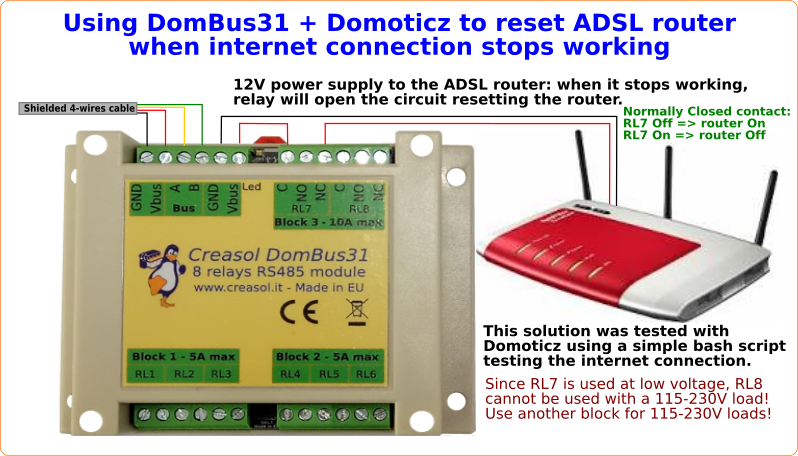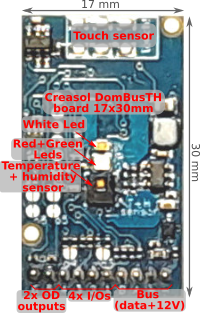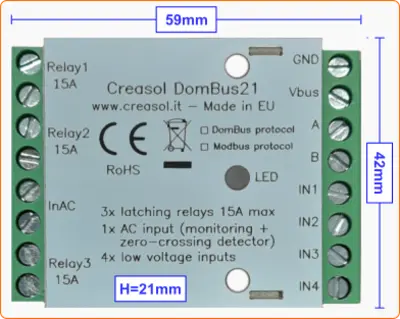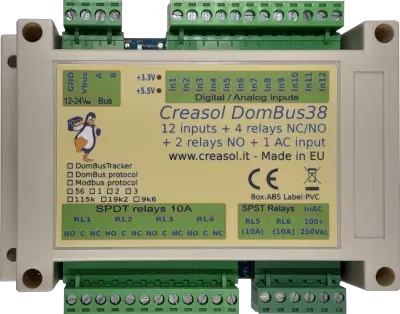
- -30%
- Nicht auf Lager
Email: store@creasol.it - Telegram: CreasolTech - Whatsapp: +393283730010
Priority Mail: schnell und günstig – Exp
Kontaktieren Sie uns, bevor Sie Produkte zur

Creasol DomBus31 ist ein Din-Rail-Relaismodul115 x 90 x 40 mm,mit 8 Relaisausgängen. 6 Relais sind SPST-Ausgänge (normalerweise offene Ausgänge) mit einer maximalen Leistung von 250 V und 5 A, und 2 Relais sind SPDT-Ausgänge (normalerweise offene und normalerweise geschlossene Ausgänge) mit einer Leistung von 10 A. Es kann über einen seriellen RS485-Bus (4 Drähte, 2 für 12 / 24V-Stromversorgung und 2 für Daten mit 115200 Bit / s) an den Domoticz-Controller angeschlossen werden.Wie andere DomBus-GeräteDomBus31 bietet eine hervorragende Leistung in Bezug auf die Leistungsoptimierung: Wenn alle 8 Relais aktiv sind (im schlimmsten Fall), beträgt der Stromverbrauch nur 500 mW!Zum Vergleich: Das KMTronic 8-Relaismodul verbraucht 12 W, die Denkovi 8-Relaiskarte verbraucht etwa 3 W, Sonoff Dual R
 Volle Unterstützung: Die meisten Produkte werden von uns entworfen!
Volle Unterstützung: Die meisten Produkte werden von uns entworfen!
Email: store@creasol.it - Telegram: CreasolTech - Whatsapp: +393283730010
 Bestellungen werden innerhalb eines Werktages versandt
Bestellungen werden innerhalb eines Werktages versandt
Priority Mail: schnell und günstig – Exp
 24 Monate Garantie, einfache Rückgabe/Rückerstattung
24 Monate Garantie, einfache Rückgabe/Rückerstattung
Kontaktieren Sie uns, bevor Sie Produkte zur
Creasol DomBus31 ist ein Din-Rail-Relaismodul115 x 90 x 40 mm,mit 8 Relaisausgängen. 6 Relais sind SPST-Ausgänge (normalerweise offene Ausgänge) mit einer maximalen Leistung von 250 V und 5 A, und 2 Relais sind SPDT-Ausgänge (normalerweise offene und normalerweise geschlossene Ausgänge) mit einer Leistung von 10 A. Es kann über einen seriellen RS485-Bus (4 Drähte, 2 für 12 / 24V-Stromversorgung und 2 für Daten mit 115200 Bit / s) an den Domoticz-Controller angeschlossen werden.
Wie andere DomBus-GeräteDomBus31 bietet eine hervorragende Leistung in Bezug auf die Leistungsoptimierung: Wenn alle 8 Relais aktiv sind (im schlimmsten Fall), beträgt der Stromverbrauch nur 500 mW!Zum Vergleich: Das KMTronic 8-Relaismodul verbraucht 12 W, die Denkovi 8-Relaiskarte verbraucht etwa 3 W, Sonoff Dual R2 verbraucht 2 W, wobei nur 2 Relais aktiviert sind.
Geeignet alsDomoticz Relaismodul: Mit einem einfachen 4-adrigen abgeschirmten Kabel ist dies möglichVersorgung und Verbindung von bis zu 30 Modulen über das RS485-ModBus-Protokollbereits in Domoticz implementiert (ein Plugin muss installiert sein):RS485 ist ein starkes Kommunikationssystem, das einfacher als Ethernet anzuschließen ist, keine HF-Verschmutzung aufweist und bereits eine 12/24-V-Stromversorgung im Buskabel enthält.
p>

 stark>
stark>
p>


Standardadresse: 0xff31
| Hafen# | Name | Fähigkeiten | Standardkonfiguration | Beschreibung |
| 1 | OUT1 | OUT_DIGITAL, OUT_RELAY_LP, OUT_BLIND | OUT_RELAY_LP | SPST-Relaisausgang, Schließer, 5A 250Vac oder 30Vdc Ausgangsleistung. Der Relaiskontakt ist durch einen Varistor geschützt |
| 2 | OUT2 | OUT_DIGITAL, OUT_RELAY_LP, OUT_BLIND | OUT_RELAY_LP | SPST-Relaisausgang, Schließer, 5A 250Vac oder 30Vdc Ausgangsleistung. Der Relaiskontakt ist durch einen Varistor geschützt |
| 3 | OUT3 | OUT_DIGITAL, OUT_RELAY_LP, OUT_BLIND | OUT_RELAY_LP | SPST-Relaisausgang, Schließer, 5A 250Vac oder 30Vdc Ausgangsleistung. Der Relaiskontakt ist durch einen Varistor geschützt |
| 4 | OUT4 | OUT_DIGITAL, OUT_RELAY_LP, OUT_BLIND | OUT_RELAY_LP | SPST-Relaisausgang, Schließer, 5A 250Vac oder 30Vdc Ausgangsleistung. Der Relaiskontakt ist durch einen Varistor geschützt |
| 5 | OUT5 | OUT_DIGITAL, OUT_RELAY_LP, OUT_BLIND | OUT_RELAY_LP | SPST-Relaisausgang, Schließer, 5A 250Vac oder 30Vdc Ausgangsleistung. Der Relaiskontakt ist durch einen Varistor geschützt |
| 6 | OUT6 | OUT_DIGITAL, OUT_RELAY_LP, OUT_BLIND | OUT_RELAY_LP | SPST-Relaisausgang, Schließer, 5A 250Vac oder 30Vdc Ausgangsleistung.Der Relaiskontakt ist durch einen Varistor geschützt |
| 7 | OUT7 | OUT_DIGITAL, OUT_RELAY_LP, OUT_BLIND | OUT_RELAY_LP | SPDT-Relaisausgang, NO + NC-Kontakte, 10A 250Vac oder 250Vdc Ausgangsleistung. Der Relaiskontakt ist durch einen Varistor geschützt |
| 8 | OUT8 | OUT_DIGITAL, OUT_RELAY_LP, OUT_BLIND(1) | OUT_RELAY_LP | SPDT-Relaisausgang, NO + NC-Kontakte, 10A 250Vac oder 250Vdc Ausgangsleistung. Der Relaiskontakt ist durch einen Varistor geschützt |
(1): Kann als BLIND-Ausgang verwendet werden, um eine Jalousie / einen Vorhang zu öffnen, aber nur der vorherige Port kann in Domoticz als OUT_BLIND konfiguriert werden, da das DomBus-Gerät bei der Konfiguration als OUT_BLIND automatisch den nächsten Port konfiguriert, um ein Relais im offenen Zustand anzutreiben Richtung.
Die folgenden einfachen Diagramme zeigen den Anschluss an eine Wärmepumpe (gesteuert durch Niederspannungssignale), ein Lüftungssystem (gesteuert durch Niederspannungssignale) und ein 3-Vias-Ventil (geliefert von 230 VAC).
Mit Domoticz ist es einfach, ein Heiz- / Kühlsystem mit einer Wärmepumpe zu erhalten, die so optimiert ist, dass sie den größten Teil der Energie aus der Photovoltaik verbraucht, und eine lufterneuerbare, kontrollierte mechanische Belüftung mit Kühler und Spule, die die relative Luftfeuchtigkeit reguliert, um maximalen Komfort zu erzielen.
Mischen Sie aus Sicherheitsgründen keine Hoch- und Niederspannungslasten im selben Block! Zum Beispiel ist es nicht sicherSchließen Sie an Block3 ein 230-V-Ventil an RL8 und ein 12/24-V-Ventil an RL7 an! An jedem Relaisblock können nur Niederspannungs- oder nur Hochspannungslasten verwendet werden.

Das folgende Schema zeigt, wie der normalerweise geschlossene Kontakt des SPDT-Relais zur Versorgung eines Routers verwendet wird.
Ein Skript überprüft, ob das Internet funktioniert, und aktiviert bei einem Fehler den Reset, um die Stromversorgung für 10 Sekunden auszuschalten und den Router zurückzusetzen.

The following video shows a presentation of some domotic modules designed and produced in Italy by Creasol to make a reliable, easy and power-optimized home automation system.
The next video shows our Smart EVSE module that can be used to charge the electric car by using only solar power, or adding 25/50/75/100% of available power from the electrical grid.
Our industrial and home automation modules are designed to be
Modules are available in two version:

Store website - Information website
For our products we can offer FULL SUPPORT and CUSTOMIZATION: please contact us by Email or Telegram
 Complete solution to make a Smart EVSE, charging the electric vehicle using only energy from renewable source (photovoltaic, wind, ...), or adding 25-50-75-100% of available power from the grid.
Complete solution to make a Smart EVSE, charging the electric vehicle using only energy from renewable source (photovoltaic, wind, ...), or adding 25-50-75-100% of available power from the grid.
 Compact board, 32x17mm, to be installed on blank cover with a 4mm hole in the middle, to exchange air for the relative humidity sensor. It can be installed in every room to monitor temperature and humidity, check alarm sensors, control blind motor UP/DOWN, send notifications (using red and green leds) and activate white led in case of power outage.
Compact board, 32x17mm, to be installed on blank cover with a 4mm hole in the middle, to exchange air for the relative humidity sensor. It can be installed in every room to monitor temperature and humidity, check alarm sensors, control blind motor UP/DOWN, send notifications (using red and green leds) and activate white led in case of power outage.
Includes:
 Very compact, versatile and cost-effective module with 9 ports. Each port can be configured by software as:
Very compact, versatile and cost-effective module with 9 ports. Each port can be configured by software as:
 Very low power consumption module designed to enable up to 3 high power loads, up to 15A (3kW).
Very low power consumption module designed to enable up to 3 high power loads, up to 15A (3kW).
 Versatile module designed to control gate or garage door.
Versatile module designed to control gate or garage door.
 DIN rail low profile module, with 8 relays and very low power consumption:
DIN rail low profile module, with 8 relays and very low power consumption:
 Versatile module with 230V inputs and outputs, and 5 low voltage I/Os.
Versatile module with 230V inputs and outputs, and 5 low voltage I/Os.
 Module designed to control 3 lights already existing and actually controlled by 230V pushbuttons and step-by-step relays. In this way each light can be activated by existing pushbuttons, and by the domotic controller.
Module designed to control 3 lights already existing and actually controlled by 230V pushbuttons and step-by-step relays. In this way each light can be activated by existing pushbuttons, and by the domotic controller.
Each relay can toggle the existing step-relay, switching the light On/Off. The optoisolator monitors the light status. The 5 I/Os can be connected to pushbuttons to activate or deactivate one or all lights.
 DIN rail module, low profile, with 12 relays outputs and very low power consumption.
DIN rail module, low profile, with 12 relays outputs and very low power consumption.
 Module designed to be connected to alarm sensors (magnetc contact sensors, PIRs, tampers): it's able to monitor mains power supply (power outage / blackout) and also have 3 relays outputs.
Module designed to be connected to alarm sensors (magnetc contact sensors, PIRs, tampers): it's able to monitor mains power supply (power outage / blackout) and also have 3 relays outputs.
 DIN rail module designed for burglar alarm system.
DIN rail module designed for burglar alarm system.
![]() DIN rail module that control azimuth + elevation/tilt motors of a sun tracker, to maximize photovoltaic energy production during the day and seasons.
DIN rail module that control azimuth + elevation/tilt motors of a sun tracker, to maximize photovoltaic energy production during the day and seasons.
 Simple module with 2 relays, to be used with DomBus modules or other electronic boards with open-collector or open-drain outputs
Simple module with 2 relays, to be used with DomBus modules or other electronic boards with open-collector or open-drain outputs
 IoT board designed for NodeMCU v3 board using ESP8266 WiFi microcontroller
IoT board designed for NodeMCU v3 board using ESP8266 WiFi microcontroller